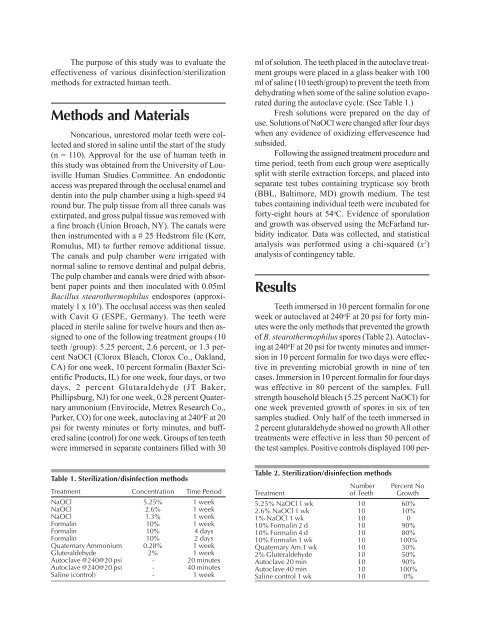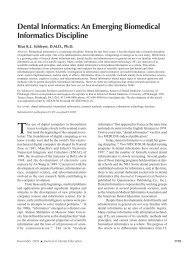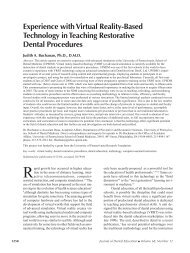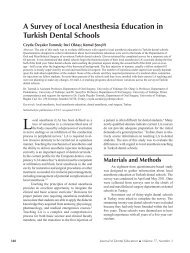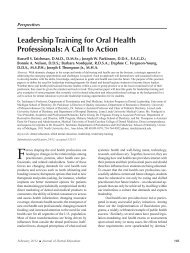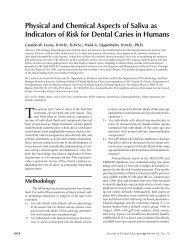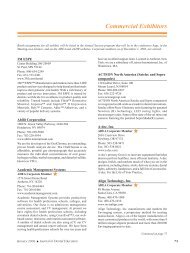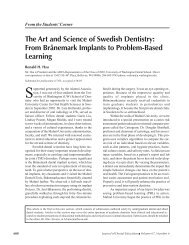Disinfection/Sterilization of Extracted Teeth for ... - ResearchGate
Disinfection/Sterilization of Extracted Teeth for ... - ResearchGate
Disinfection/Sterilization of Extracted Teeth for ... - ResearchGate
Create successful ePaper yourself
Turn your PDF publications into a flip-book with our unique Google optimized e-Paper software.
The purpose <strong>of</strong> this study was to evaluate the<br />
effectiveness <strong>of</strong> various disinfection/sterilization<br />
methods <strong>for</strong> extracted human teeth.<br />
Methods and Materials<br />
Noncarious, unrestored molar teeth were collected<br />
and stored in saline until the start <strong>of</strong> the study<br />
(n = 110). Approval <strong>for</strong> the use <strong>of</strong> human teeth in<br />
this study was obtained from the University <strong>of</strong> Louisville<br />
Human Studies Committee. An endodontic<br />
access was prepared through the occlusal enamel and<br />
dentin into the pulp chamber using a high-speed #4<br />
round bur. The pulp tissue from all three canals was<br />
extirpated, and gross pulpal tissue was removed with<br />
a fine broach (Union Broach, NY). The canals were<br />
then instrumented with a # 25 Hedstrom file (Kerr,<br />
Romulus, MI) to further remove additional tissue.<br />
The canals and pulp chamber were irrigated with<br />
normal saline to remove dentinal and pulpal debris.<br />
The pulp chamber and canals were dried with absorbent<br />
paper points and then inoculated with 0.05ml<br />
Bacillus stearothermophilus endospores (approximately<br />
1 x 10 5 ). The occlusal access was then sealed<br />
with Cavit G (ESPE, Germany). The teeth were<br />
placed in sterile saline <strong>for</strong> twelve hours and then assigned<br />
to one <strong>of</strong> the following treatment groups (10<br />
teeth /group): 5.25 percent, 2.6 percent, or 1.3 percent<br />
NaOCl (Clorox Bleach, Clorox Co., Oakland,<br />
CA) <strong>for</strong> one week, 10 percent <strong>for</strong>malin (Baxter Scientific<br />
Products, IL) <strong>for</strong> one week, four days, or two<br />
days, 2 percent Glutaraldehyde (JT Baker,<br />
Phillipsburg, NJ) <strong>for</strong> one week, 0.28 percent Quaternary<br />
ammonium (Envirocide, Metrex Research Co.,<br />
Parker, CO) <strong>for</strong> one week, autoclaving at 240 o F at 20<br />
psi <strong>for</strong> twenty minutes or <strong>for</strong>ty minutes, and buffered<br />
saline (control) <strong>for</strong> one week. Groups <strong>of</strong> ten teeth<br />
were immersed in separate containers filled with 30<br />
ml <strong>of</strong> solution. The teeth placed in the autoclave treatment<br />
groups were placed in a glass beaker with 100<br />
ml <strong>of</strong> saline (10 teeth/group) to prevent the teeth from<br />
dehydrating when some <strong>of</strong> the saline solution evaporated<br />
during the autoclave cycle. (See Table 1.)<br />
Fresh solutions were prepared on the day <strong>of</strong><br />
use. Solutions <strong>of</strong> NaOCl were changed after four days<br />
when any evidence <strong>of</strong> oxidizing effervescence had<br />
subsided.<br />
Following the assigned treatment procedure and<br />
time period, teeth from each group were aseptically<br />
split with sterile extraction <strong>for</strong>ceps, and placed into<br />
separate test tubes containing trypticase soy broth<br />
(BBL, Baltimore, MD) growth medium. The test<br />
tubes containing individual teeth were incubated <strong>for</strong><br />
<strong>for</strong>ty-eight hours at 54 o C. Evidence <strong>of</strong> sporulation<br />
and growth was observed using the McFarland turbidity<br />
indicator. Data was collected, and statistical<br />
analysis was per<strong>for</strong>med using a chi-squared (x 2 )<br />
analysis <strong>of</strong> contingency table.<br />
Results<br />
<strong>Teeth</strong> immersed in 10 percent <strong>for</strong>malin <strong>for</strong> one<br />
week or autoclaved at 240 o F at 20 psi <strong>for</strong> <strong>for</strong>ty minutes<br />
were the only methods that prevented the growth<br />
<strong>of</strong> B. stearothermophilus spores (Table 2). Autoclaving<br />
at 240 o F at 20 psi <strong>for</strong> twenty minutes and immersion<br />
in 10 percent <strong>for</strong>malin <strong>for</strong> two days were effective<br />
in preventing microbial growth in nine <strong>of</strong> ten<br />
cases. Immersion in 10 percent <strong>for</strong>malin <strong>for</strong> four days<br />
was effective in 80 percent <strong>of</strong> the samples. Full<br />
strength household bleach (5.25 percent NaOCl) <strong>for</strong><br />
one week prevented growth <strong>of</strong> spores in six <strong>of</strong> ten<br />
samples studied. Only half <strong>of</strong> the teeth immersed in<br />
2 percent glutaraldehyde showed no growth All other<br />
treatments were effective in less than 50 percent <strong>of</strong><br />
the test samples. Positive controls displayed 100 per-<br />
Table 1. <strong>Sterilization</strong>/disinfection methods<br />
Treatment Concentration Time Period<br />
NaOCl 5.25% 1 week<br />
NaOCl 2.6% 1 week<br />
NaOCl 1.3% 1 week<br />
Formalin 10% 1 week<br />
Formalin 10% 4 days<br />
Formalin 10% 2 days<br />
Quaternary Ammonium 0.28% 1 week<br />
Gluteraldehyde 2% 1 week<br />
Autoclave @240@20 psi - 20 minutes<br />
Autoclave @240@20 psi - 40 minutes<br />
Saline (control) - 1 week<br />
Table 2. <strong>Sterilization</strong>/disinfection methods<br />
Number Percent No<br />
Treatment <strong>of</strong> <strong>Teeth</strong> Growth<br />
5.25% NaOCl 1 wk 10 60%<br />
2.6% NaOCl 1 wk 10 10%<br />
1% NaOCl 1 wk 10 0<br />
10% Formalin 2 d 10 90%<br />
10% Formalin 4 d 10 80%<br />
10% Formalin 1 wk 10 100%<br />
Quaternary Am.1 wk 10 30%<br />
2% Gluteraldehyde 10 50%<br />
Autoclave 20 min 10 90%<br />
Autoclave 40 min 10 100%<br />
Saline control 1 wk 10 0%


